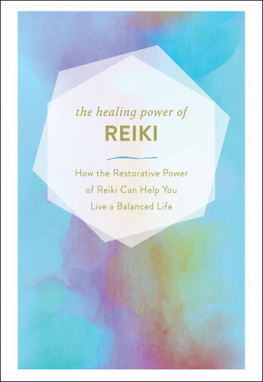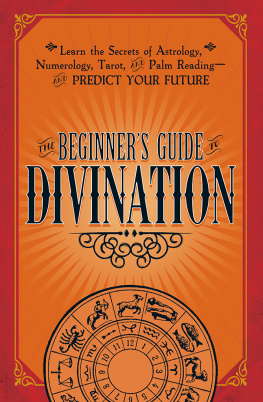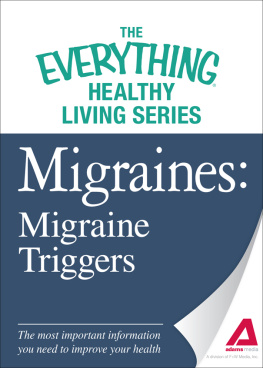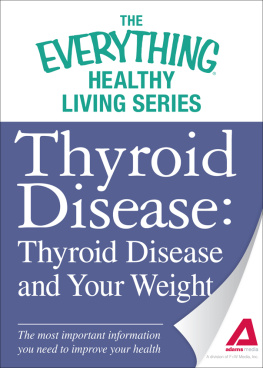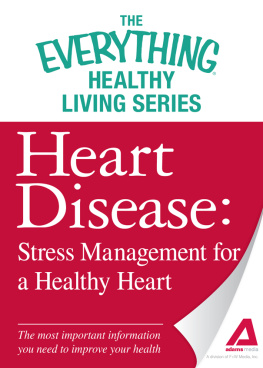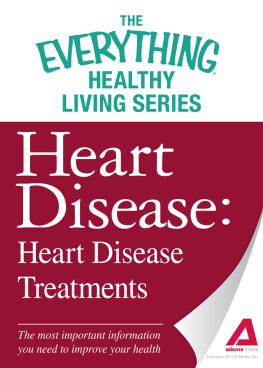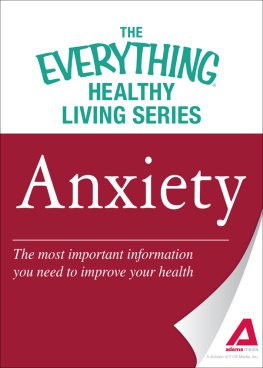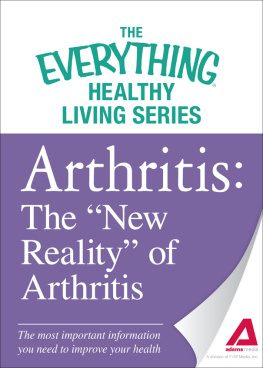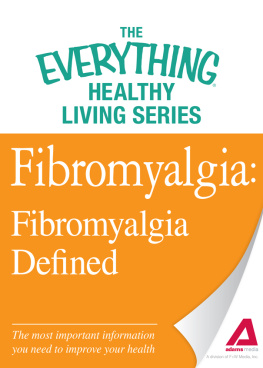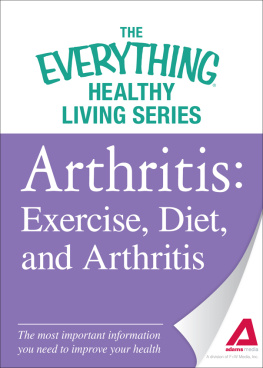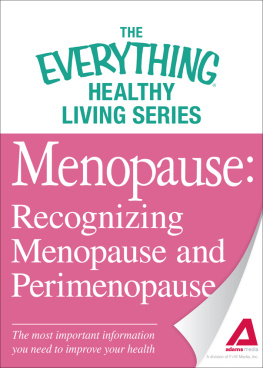Adams Media, a division of F+W Media, Inc.
For more than 10 years, millions of readers have trusted the bestselling Everything series for expert advice and important information on health topics ranging from pregnancy and postpartum care to heart health, anxiety, and diabetes. Packed with the most recent, up-to-date data, Everything health guides help you get the right diagnosis, choose the best doctor, and find the treatment options that work for you.
The Everything Healthy Living Series books are concise guides, focusing on only the essential information you need. Whether youre looking for an overview of traditional and alternative migraine treatments, advice on starting a heart-healthy lifestyle, or suggestions for finding the right medical team, theres an Everything Healthy Living Book for you.
Arthritis
It can be completely unnerving to have nothing wrong with you one day and severe pain the next day. Since pain is a somewhat common symptom associated with many different conditions, it is hard to know initially what to do or how to react to the sudden change. Not every type of arthritis develops suddenly, but that sense of confusion that builds when you accept that its not going to go away can sometimes lead you down the wrong path.
No matter what type of arthritis you have, early diagnosis and early treatment can help prevent joint damage and disability. There are many approaches to treating arthritis, both conventional and alternative. There are myriad books written on the subject. The Internet provides even more information about arthritis. It can almost be considered too much information, because a person experiencing the initial onset of arthritis symptoms often doesnt know where to begin. Should you pick up a book about osteoarthritis and learn all about it? Maybe you should choose the book about rheumatoid arthritis? Perhaps its sufficient to self-treat with over-the-counter arthritis medications? How do you know you are making the right decisions?
Choosing the right starting point can impact the course of your disease. Its imperative to be evaluated by a rheumatologist, a specialist in diagnosing and treating arthritis and related conditions. Getting an accurate diagnosis is the first step to getting proper treatment and managing the disease.
Chronic arthritis affects every aspect of daily living. This practical guide will show you how to live better with arthritis. The day you are diagnosed with arthritis is the first day of your new reality. Your new reality can overwhelm you, or you can choose to face it with courage and perseverance. Your willingness to accept your new reality and adjust and adapt to it, as well as your ability to cope and an unwillingness to give up, are all factors that will influence how well you live with arthritis.
The intent of this book is to help you learn about the disease, teach you to be your own advocate, help you make better decisions, and inspire you to realize that there is still a high quality of life after an arthritis diagnosis. The first step: Understanding that change is inevitable.
If youd like to learn more about arthritis, check out The Everything Health Guide to Arthritis , available in print (978-1-59869-410-9) and eBook (978-1-60550-230-4) formats.
Common Types of Arthritis
Though the name seems representative of a single disease, arthritis is actually a group of diseases that have symptoms affecting the joints of the body and the tissues that surround the joints. Over 100 different types of arthritis range from mild forms of the disease to types that can be severe and disabling. Some types are rare, while about a dozen are considered common types of arthritis.
Osteoarthritis
Osteoarthritis is the most common type of arthritis. It is the type of arthritis most people are familiar with because it is most prevalent and is associated with aging. Osteoarthritis is also known by other names that are more reflective of the underlying disease process, including: wear-and-tear arthritis, degenerative arthritis, degenerative joint disease, and osteoarthrosis.
In a healthy person, the ends of the bones that form a joint are cushioned by cartilage, allowing for smooth, unconstrained movement of the joint. With osteoarthritis, the cartilage breaks down and deteriorates. As the cartilage deteriorates and is worn away, bone rubs on bone, resulting in pain, stiffness, and reduced mobility.
Bone spurs (also known as osteophytes) may develop which intrude on the joint space and fragments of bone may dislodge, which also interferes with normal movement of the joint. The lining of the joint, or synovium, becomes inflamed as cartilage breaks down, starting a process which itself causes even more cartilage deterioration and joint damage.
Symptoms of Osteoarthritis
Osteoarthritis can affect any joint, but the weight-bearing joints of the hips, knees, and spine are most commonly symptomatic. It is also not unusual for osteoarthritis to develop in the joints of the fingers or feet. A single joint or multiple joints may be affected by osteoarthritis.
Alert
According to the Arthritis Foundation, osteoarthritis of the knees and hips is the most common cause of arthritis-related disability in the United States. In people who have knee osteoarthritis, moderate physical activity at least three times per week can reduce the risk of arthritis-related disability by 47 percent.
Signs and symptoms associated with osteoarthritis include:
- Gradual onset of symptoms
- Joint stiffness in the morning, which usually lasts less than one half hour
- Joint stiffness following inactivity or staying in one position for a prolonged period
- Joint pain or stiffness following overuse of the affected joint
- Joint pain that is typically worse in the evening than the morning
- Limited range of motion in the affected joint
- Joints that lock up or feel like they are giving out
- Localized inflammation
- Bony outgrowths
- Crepitus (a crackling noise)
Diagnosis and Treatment of Osteoarthritis
X-ray evidence of joint damage, a physical examination performed by your doctor, and a medical history that includes details about the onset of symptoms help diagnose osteoarthritis. Blood tests are ordered for the purpose of ruling out other types of arthritis. For example, blood test results that are abnormal in rheumatoid arthritis or other inflammatory forms of arthritis are usually normal in cases of osteoarthritis.
Though there is no cure for osteoarthritis, treatment is aimed at controlling symptoms, preserving residual joint function, and improving mobility. Medications are commonly prescribed to treat osteoarthritis (for example, NSAIDs and analgesics). Local injections of corticosteroids or viscosupplementation agents are also treatment options.
Some osteoarthritis patients find relief from topical creams or certain nutritional supplements. You may find that hot or cold packs can relieve symptoms. The benefits of exercise, physical therapy, and weight management cant be understated for controlling pain and symptoms associated with osteoarthritis. Surgery, though considered a last-resort treatment option for severe cases, can yield dramatic results.




